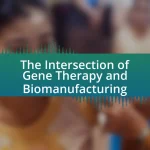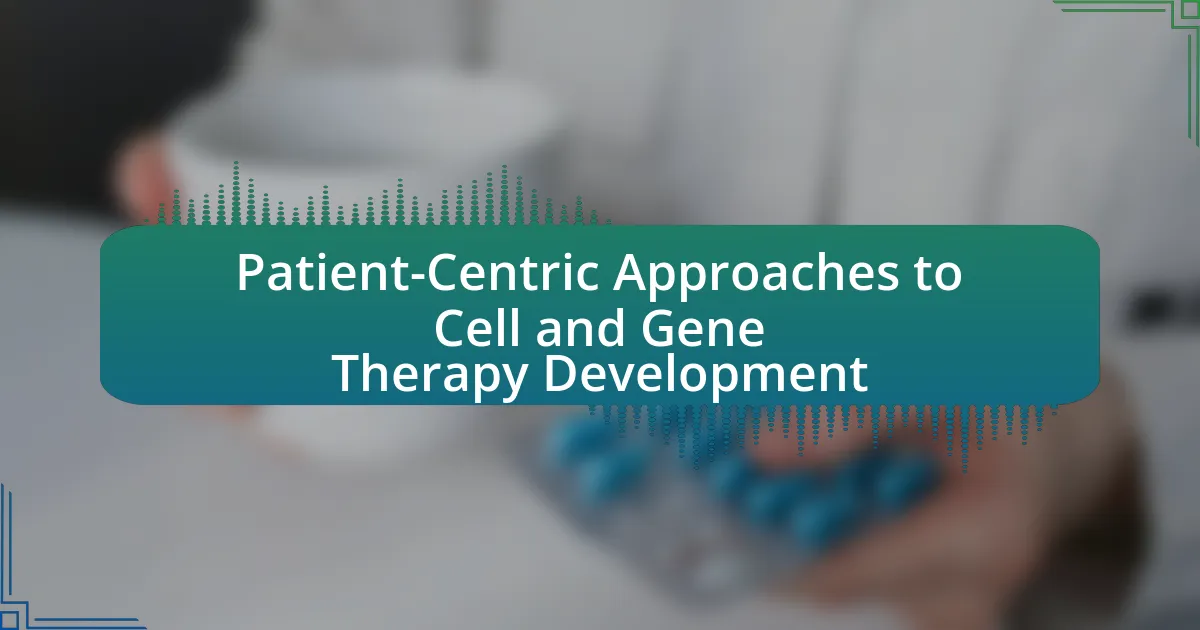Exosomes are small extracellular vesicles that play a vital role in intercellular communication and are increasingly recognized for their potential in cell and gene therapy. This article explores the characteristics of exosomes, their unique properties that make them suitable for therapeutic applications, and their ability to enhance the delivery of therapeutic agents. It also addresses the challenges associated with exosome isolation and characterization, safety and efficacy considerations in gene therapy, and future directions for research in this field. By examining the applications of exosomes in regenerative medicine and targeted therapies, the article highlights their significance as a promising tool in innovative treatment strategies.

What are Exosomes and Their Role in Cell and Gene Therapy?
Exosomes are small extracellular vesicles, typically ranging from 30 to 150 nanometers in diameter, that are secreted by various cell types and play a crucial role in intercellular communication. In cell and gene therapy, exosomes serve as vehicles for delivering therapeutic molecules, such as proteins, lipids, and RNA, to target cells, thereby enhancing the efficacy of treatments. Research indicates that exosomes can facilitate the transfer of genetic material, which can modify gene expression in recipient cells, making them valuable in gene therapy applications. For instance, studies have shown that exosomes derived from stem cells can promote tissue regeneration and modulate immune responses, highlighting their potential in therapeutic strategies for various diseases.
How are Exosomes Defined in the Context of Therapy?
Exosomes are defined in the context of therapy as nanoscale extracellular vesicles that facilitate intercellular communication and transport biomolecules, including proteins, lipids, and RNA. These vesicles play a crucial role in therapeutic applications by serving as vehicles for drug delivery, enhancing the efficacy of treatments, and modulating immune responses. Research has demonstrated that exosomes can be engineered to carry therapeutic agents, which allows for targeted delivery to specific cells, thereby improving treatment outcomes in various diseases, including cancer and genetic disorders. For instance, a study published in “Nature Biotechnology” by Zhang et al. (2019) highlighted the potential of exosome-based therapies in delivering RNA therapeutics, showcasing their ability to improve gene expression in target cells.
What are the key characteristics of Exosomes?
Exosomes are small extracellular vesicles, typically ranging from 30 to 150 nanometers in diameter, that play a crucial role in intercellular communication. They are characterized by their lipid bilayer membrane, which encapsulates proteins, lipids, and nucleic acids, allowing them to transport molecular signals between cells. Exosomes are produced by various cell types and are involved in numerous biological processes, including immune response modulation, tissue repair, and the spread of diseases such as cancer. Their ability to carry specific cargo reflective of their cell of origin enhances their potential as therapeutic agents in cell and gene therapy, as evidenced by studies demonstrating their role in delivering RNA and proteins to target cells effectively.
How do Exosomes differ from other extracellular vesicles?
Exosomes differ from other extracellular vesicles primarily in their size, biogenesis, and content. Exosomes are typically 30 to 150 nanometers in diameter and originate from the inward budding of the endosomal membrane, forming multivesicular bodies that release exosomes upon fusion with the plasma membrane. In contrast, other extracellular vesicles, such as microvesicles, are larger (100 to 1000 nanometers) and are formed by direct budding from the plasma membrane. Additionally, exosomes have a distinct molecular composition, often enriched with specific proteins, lipids, and RNA that reflect their cellular origin, which is crucial for their role in intercellular communication and therapeutic applications in cell and gene therapy.
Why are Exosomes Considered a New Frontier in Therapy?
Exosomes are considered a new frontier in therapy due to their ability to facilitate intercellular communication and deliver therapeutic molecules effectively. These extracellular vesicles, which are secreted by various cell types, play a crucial role in transferring proteins, lipids, and RNA between cells, thereby influencing numerous biological processes. Research has shown that exosomes can be engineered to carry specific therapeutic agents, enhancing targeted delivery and reducing side effects compared to traditional methods. For instance, a study published in “Nature Biotechnology” by Zhang et al. (2019) demonstrated that exosomes derived from stem cells could promote tissue regeneration and repair by delivering growth factors directly to damaged tissues. This capability positions exosomes as a promising tool in regenerative medicine and targeted therapies, making them a significant focus in the development of innovative treatment strategies.
What unique properties make Exosomes suitable for therapeutic applications?
Exosomes are suitable for therapeutic applications due to their ability to facilitate intercellular communication, their natural origin, and their capacity to carry diverse biomolecules. These small extracellular vesicles can transfer proteins, lipids, and RNA between cells, which is crucial for modulating immune responses and promoting tissue repair. Their lipid bilayer protects the cargo from degradation, enhancing stability and bioavailability. Additionally, exosomes can be engineered for targeted delivery, allowing for precise therapeutic interventions. Studies have shown that exosomes derived from stem cells can promote regeneration in damaged tissues, highlighting their potential in regenerative medicine.
How do Exosomes facilitate intercellular communication?
Exosomes facilitate intercellular communication by serving as vehicles for the transfer of proteins, lipids, and RNA between cells. These small extracellular vesicles, typically ranging from 30 to 150 nanometers in diameter, are released by various cell types and can influence the behavior of recipient cells through the delivery of bioactive molecules. Research has shown that exosomes can modulate immune responses, promote tissue repair, and even alter gene expression in target cells, thereby playing a crucial role in physiological and pathological processes. For instance, a study published in “Nature Communications” by Zhang et al. (2019) demonstrated that exosomes derived from mesenchymal stem cells could enhance the regenerative capacity of damaged tissues by transferring specific microRNAs that promote cell survival and proliferation.

What Applications Do Exosomes Have in Cell Therapy?
Exosomes have significant applications in cell therapy, primarily as vehicles for delivering therapeutic molecules, including proteins, lipids, and RNA. These extracellular vesicles facilitate intercellular communication and can modulate immune responses, making them valuable in treating various diseases, including cancer and neurodegenerative disorders. Research indicates that exosomes derived from stem cells can promote tissue regeneration and repair by transferring bioactive molecules that enhance cell survival and proliferation. For instance, a study published in “Nature Communications” by Zhang et al. (2019) demonstrated that exosomes from mesenchymal stem cells improved cardiac function in a mouse model of myocardial infarction, highlighting their potential in regenerative medicine.
How are Exosomes Used to Enhance Cell Therapy Outcomes?
Exosomes are utilized to enhance cell therapy outcomes by facilitating intercellular communication and delivering bioactive molecules that promote tissue repair and regeneration. These extracellular vesicles contain proteins, lipids, and RNA that can modulate immune responses, promote cell survival, and enhance the therapeutic effects of stem cells. For instance, studies have shown that exosomes derived from mesenchymal stem cells can improve cardiac function after myocardial infarction by reducing inflammation and promoting angiogenesis, as evidenced by research published in the journal “Stem Cells” by Zhang et al. (2015). This demonstrates the significant role exosomes play in augmenting the efficacy of cell therapies.
What types of cells can be modified using Exosomes?
Exosomes can modify various types of cells, including immune cells, stem cells, and cancer cells. Research indicates that exosomes derived from mesenchymal stem cells can enhance the regenerative potential of target cells, while exosomes from immune cells can modulate immune responses. Additionally, exosomes have been shown to facilitate communication between cancer cells and their microenvironment, influencing tumor progression and metastasis. This versatility underscores the potential of exosomes in therapeutic applications across different cell types.
How do Exosomes improve the delivery of therapeutic agents?
Exosomes improve the delivery of therapeutic agents by serving as natural carriers that facilitate the transport of drugs, proteins, and nucleic acids to target cells. These extracellular vesicles possess a lipid bilayer that protects the cargo from degradation, enhancing stability and bioavailability. Research indicates that exosomes can effectively cross biological barriers, such as the blood-brain barrier, which is crucial for treating neurological disorders. Additionally, exosomes can be engineered to enhance targeting specificity, allowing for the selective delivery of therapeutics to diseased tissues while minimizing off-target effects. Studies have shown that exosome-mediated delivery can increase the therapeutic efficacy of various agents, including RNA-based therapies and small molecules, by improving cellular uptake and reducing systemic toxicity.
What Challenges Exist in the Use of Exosomes for Cell Therapy?
The challenges in the use of exosomes for cell therapy include issues related to isolation, characterization, scalability, and regulatory hurdles. Isolation techniques often yield low purity and yield, complicating the therapeutic application of exosomes. Characterization is challenging due to the heterogeneity of exosome populations, which can affect their functionality and efficacy. Scalability remains a significant barrier, as current methods may not support large-scale production necessary for clinical applications. Additionally, regulatory frameworks for exosome-based therapies are still evolving, leading to uncertainties in approval processes and quality control standards. These factors collectively hinder the advancement of exosome-based cell therapies in clinical settings.
What are the current limitations in Exosome isolation and characterization?
Current limitations in exosome isolation and characterization include low yield, contamination with non-exosomal vesicles, and variability in isolation methods. Low yield affects the quantity of exosomes obtained, making it challenging to conduct comprehensive analyses. Contamination with proteins and other vesicles can lead to inaccurate characterization, as it complicates the identification of exosomal markers. Additionally, the lack of standardized protocols across different isolation techniques, such as ultracentrifugation, precipitation, and affinity-based methods, results in variability in exosome quality and composition, which hinders reproducibility in research and clinical applications.
How can the stability of Exosomes be improved for therapeutic use?
The stability of exosomes can be improved for therapeutic use by employing various methods such as freeze-drying, chemical stabilization, and encapsulation techniques. Freeze-drying, or lyophilization, preserves exosome integrity and functionality by removing water, which is crucial for maintaining their structural stability during storage. Chemical stabilization involves the use of agents like trehalose or sucrose, which protect exosomes from degradation by stabilizing their lipid bilayers. Encapsulation techniques, such as using liposomes or polymeric nanoparticles, can further enhance the stability of exosomes by providing a protective environment that shields them from environmental stressors. These methods have been supported by studies demonstrating that lyophilized exosomes retain their biological activity and therapeutic potential after rehydration, making them suitable for clinical applications.

What Role Do Exosomes Play in Gene Therapy?
Exosomes play a crucial role in gene therapy by serving as natural carriers for delivering therapeutic genetic material to target cells. These extracellular vesicles facilitate intercellular communication and can encapsulate various biomolecules, including RNA and proteins, which are essential for gene modulation. Research has demonstrated that exosomes can enhance the stability and bioavailability of therapeutic agents, thereby improving the efficacy of gene therapy approaches. For instance, studies have shown that exosomes derived from stem cells can effectively deliver small interfering RNA (siRNA) to target cells, leading to significant gene silencing and therapeutic outcomes in various disease models.
How do Exosomes Contribute to Gene Delivery Mechanisms?
Exosomes contribute to gene delivery mechanisms by serving as natural carriers that encapsulate and transport nucleic acids, including mRNA and miRNA, to target cells. These extracellular vesicles facilitate cellular communication and can enhance the uptake of genetic material due to their lipid bilayer structure, which allows for fusion with recipient cell membranes. Studies have shown that exosomes can effectively deliver therapeutic genes, improving the efficiency of gene therapy approaches. For instance, research published in “Nature Communications” by Zhang et al. (2019) demonstrated that exosomes derived from mesenchymal stem cells could deliver siRNA to target cells, resulting in significant gene silencing effects. This evidence underscores the potential of exosomes as a promising tool in gene delivery systems.
What types of genetic material can be delivered using Exosomes?
Exosomes can deliver various types of genetic material, including messenger RNA (mRNA), microRNA (miRNA), and DNA. These small extracellular vesicles play a crucial role in intercellular communication and can transport these genetic materials to recipient cells, influencing their behavior and function. Studies have shown that exosomes derived from different cell types can encapsulate and protect mRNA and miRNA, facilitating their stability and uptake by target cells, which is essential for therapeutic applications in gene therapy.
How do Exosomes enhance the efficiency of gene transfer?
Exosomes enhance the efficiency of gene transfer by serving as natural carriers that facilitate the delivery of genetic material to target cells. These extracellular vesicles possess a lipid bilayer that protects the cargo, such as RNA and proteins, from degradation, thereby increasing the stability and bioavailability of the genetic material. Studies have shown that exosomes can efficiently fuse with recipient cell membranes, promoting the uptake of their contents. For instance, research published in “Nature Communications” by Zhang et al. (2019) demonstrated that exosomes derived from mesenchymal stem cells significantly improved the delivery of therapeutic RNA, resulting in enhanced gene expression in target cells. This ability to mediate intercellular communication and transfer genetic information makes exosomes a promising tool in gene therapy applications.
What are the Safety and Efficacy Considerations for Exosome-Based Gene Therapy?
Exosome-based gene therapy presents both safety and efficacy considerations that are critical for its application. Safety concerns primarily involve the potential for immunogenicity, as exosomes derived from different cell types may elicit immune responses in recipients. Additionally, the risk of unintended delivery of genetic material to non-target cells raises concerns about off-target effects and potential toxicity. Efficacy considerations include the ability of exosomes to effectively deliver therapeutic genes to target cells, which is influenced by their natural targeting capabilities and the methods used for loading therapeutic cargo. Studies have shown that exosomes can enhance gene delivery efficiency, as evidenced by research indicating that exosome-mediated delivery can achieve higher transfection rates compared to conventional methods (source: “Exosomes as Drug Delivery Systems: A Review,” authors: Zhang et al., 2020). Thus, while exosome-based gene therapy holds promise, careful evaluation of safety and efficacy is essential for its successful clinical implementation.
What potential immunogenic responses can arise from Exosome use?
Exosome use can elicit various immunogenic responses, including the activation of immune cells and the production of antibodies. These responses occur because exosomes can carry proteins, lipids, and nucleic acids that may be recognized as foreign by the immune system. For instance, studies have shown that exosomes derived from different cell types can induce T cell activation and cytokine release, indicating a potential for immune recognition. Additionally, the presence of specific surface markers on exosomes can trigger innate immune responses, leading to inflammation. This immunogenicity is a critical consideration in the therapeutic application of exosomes in cell and gene therapy, as it may influence their efficacy and safety profiles.
How is the therapeutic window determined for Exosome-based treatments?
The therapeutic window for exosome-based treatments is determined through a combination of pharmacokinetic studies, dose-response assessments, and safety evaluations. Pharmacokinetic studies analyze the absorption, distribution, metabolism, and excretion of exosomes in biological systems, which helps establish optimal dosing regimens. Dose-response assessments identify the relationship between the dose of exosomes and the therapeutic effect, allowing researchers to pinpoint the effective dose range. Safety evaluations ensure that the treatment does not produce adverse effects at therapeutic doses. Collectively, these methodologies provide a comprehensive understanding of the therapeutic window, ensuring efficacy while minimizing toxicity.
What Future Directions Exist for Exosome Research in Therapy?
Future directions for exosome research in therapy include enhancing their use as drug delivery vehicles, improving their isolation and characterization methods, and exploring their role in regenerative medicine. Researchers are focusing on engineering exosomes to carry therapeutic agents more effectively, which could lead to targeted treatments for various diseases. Additionally, advancements in nanotechnology and molecular biology are expected to refine exosome production techniques, making them more efficient and scalable. Studies have shown that exosomes can facilitate tissue repair and modulate immune responses, indicating their potential in treating conditions like cancer and neurodegenerative diseases.
What innovations are being explored to improve Exosome functionality?
Innovations being explored to improve exosome functionality include engineering exosomes for targeted delivery, enhancing their stability, and increasing their loading capacity for therapeutic agents. Researchers are utilizing techniques such as genetic modification of donor cells to produce exosomes with specific surface markers, which allows for targeted delivery to desired tissues or cells. Additionally, advancements in nanotechnology are being applied to improve the stability of exosomes in circulation, thereby prolonging their therapeutic effects. Studies have shown that modifying the lipid composition of exosomes can significantly enhance their ability to encapsulate and deliver RNA molecules, which is crucial for gene therapy applications.
How can regulatory frameworks adapt to accommodate Exosome therapies?
Regulatory frameworks can adapt to accommodate exosome therapies by establishing specific guidelines that address their unique properties and therapeutic applications. These adaptations may include defining exosomes as biological products, which would necessitate tailored preclinical and clinical evaluation processes that consider their complex biological behavior and mechanisms of action. For instance, the U.S. Food and Drug Administration (FDA) has begun to recognize the need for distinct regulatory pathways for cell and gene therapies, which could extend to exosome-based treatments, ensuring safety and efficacy through rigorous testing protocols. Additionally, international regulatory bodies, such as the European Medicines Agency (EMA), are also exploring frameworks that could facilitate the approval of exosome therapies, reflecting a growing consensus on the importance of adapting regulations to keep pace with scientific advancements in regenerative medicine.
What Best Practices Should Be Followed When Utilizing Exosomes in Therapy?
Best practices for utilizing exosomes in therapy include ensuring rigorous characterization of exosome populations, maintaining sterile conditions during isolation and handling, and optimizing dosage and delivery methods. Characterization involves assessing size, concentration, and surface markers to confirm exosome identity and functionality, which is crucial for therapeutic efficacy. Maintaining sterility prevents contamination that could compromise treatment outcomes. Additionally, optimizing dosage and delivery methods, such as intravenous or localized administration, enhances therapeutic effectiveness and minimizes side effects. These practices are supported by studies demonstrating that proper characterization and handling significantly improve the reproducibility and safety of exosome-based therapies.




